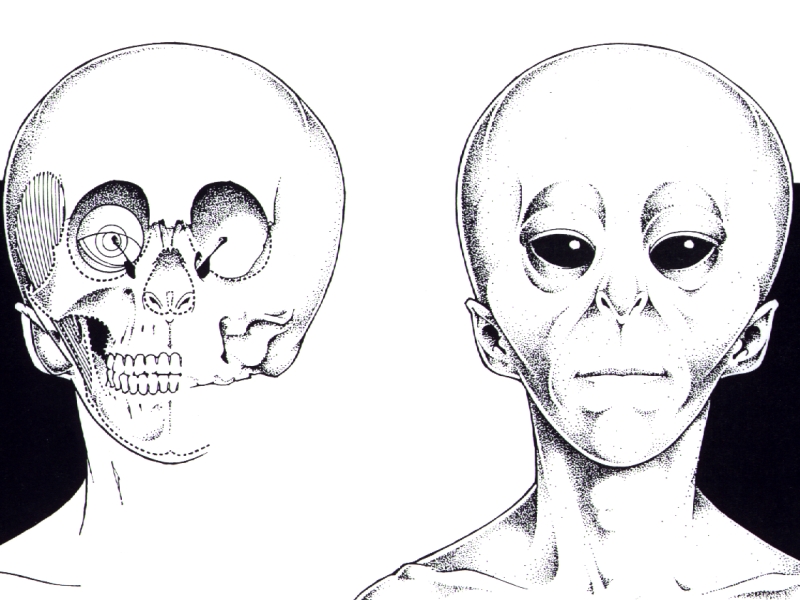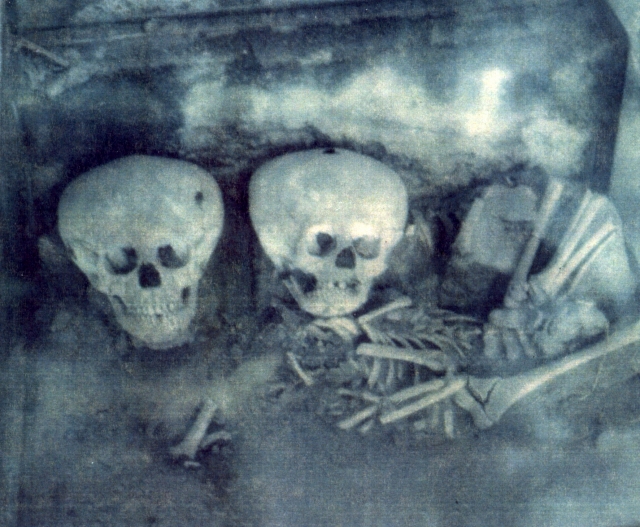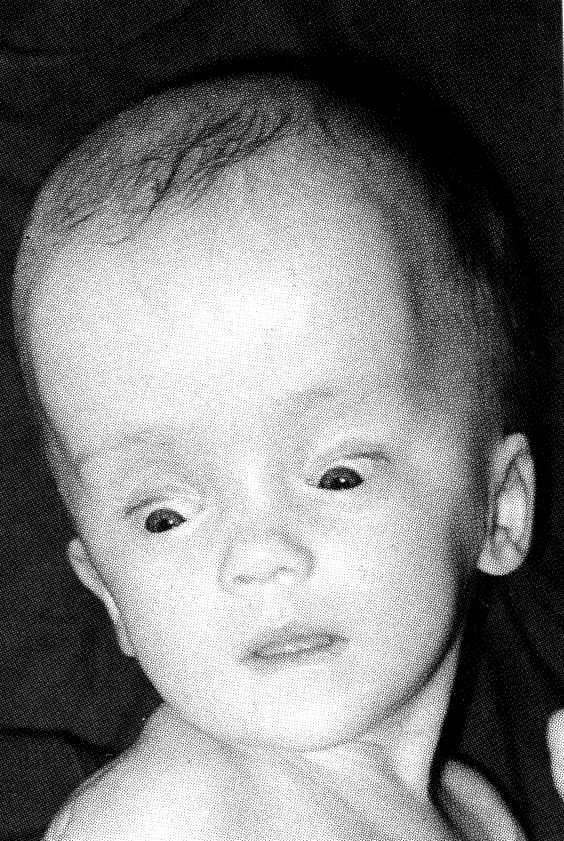07.20The Starchild Project
February 2006
by Steven Novella, MD
 An American couple present to the media the skull of a child they claim was obtained 60-70 years ago from a cave in Mexico. The cranial cavity of this skull is grotesquely enlarged, and the other features appear human, but in a distorted form. The media dub the skull the “starchild,” and speculate freely about the creature to whom it once belonged. Conservative scientists are convinced that the skull represents a severe congenital abnormality, but require more thorough examination before they can be more specific. Other investigators, however, reject this conclusion, and claim instead that the skull belongs either to an alien or an alien-human hybrid. They then begin an elaborate grass-roots campaign to convince the public of this startling conclusion, with some success.
An American couple present to the media the skull of a child they claim was obtained 60-70 years ago from a cave in Mexico. The cranial cavity of this skull is grotesquely enlarged, and the other features appear human, but in a distorted form. The media dub the skull the “starchild,” and speculate freely about the creature to whom it once belonged. Conservative scientists are convinced that the skull represents a severe congenital abnormality, but require more thorough examination before they can be more specific. Other investigators, however, reject this conclusion, and claim instead that the skull belongs either to an alien or an alien-human hybrid. They then begin an elaborate grass-roots campaign to convince the public of this startling conclusion, with some success.
Skeptics are all too familiar with the above sequence of events. The details, of course, change from episode to episode, but the themes are always the same. At the heart of the conflict is the difference in method between conventional, conservative, mainstream science, and what Carl Sagan dubbed “the cheap imitation,” or what skeptics call “pseudoscience.”
The Starchild Project
About 60 or 70 years ago, an American girl living in Mexico allegedly discovered the skeletal remains of an adult and an apparently malformed child in a cave near her village. The girl collected both skulls and kept them for her entire life, until her recent death. Just prior to her death she passed the skulls to an unnamed American man, who kept them for five years. The skulls were then passed to an American couple, who possess them to this day.
 This is at least the story as it has come to be told about the so-called starchild. The skulls and the story they tell is certainly an interesting one. It is interesting to speculate about why the adult and child died in that cave. What was the cause of the child’s malformations? Were they congenital, acquired or something else? Were they the cause of the child’s death? Did the parent die of grief from their lost child, or were they both outcasts from their village? Certainly, a compelling human interest story must lie behind the remains of an adult and malformed child found lying side by side in a cave in Mexico.
This is at least the story as it has come to be told about the so-called starchild. The skulls and the story they tell is certainly an interesting one. It is interesting to speculate about why the adult and child died in that cave. What was the cause of the child’s malformations? Were they congenital, acquired or something else? Were they the cause of the child’s death? Did the parent die of grief from their lost child, or were they both outcasts from their village? Certainly, a compelling human interest story must lie behind the remains of an adult and malformed child found lying side by side in a cave in Mexico.
There is a tendency, however, to fill such speculation with the mythology of the local culture. Today, one of the prevailing mythologies of our time concerns the visitation of our planet by small gray aliens who are conducting a mysterious campaign of human abduction, perhaps involving a project of interbreeding. It is no surprise, therefore, that those who believe in and popularize this mythology have seized upon the story of these two skulls and interpreted the details in line with their beliefs.
Two such believers, Lloyd Pye and Mark Bean, have put together what they call the Starchild Project, and have an extensive website dedicated to their investigation of these skulls (Pye and Bean, 1999). Here is an excerpt from their introduction:
“As reported by its discoverer, the Starchild skull is ‘malformed’ in many key ways. In fact, little about it compares to a normal human. It does possess the same number and kind of cranial bones…However, none are shaped or positioned as in humans. There are also other similarities, including certain bone extrusions and contours, muscle attachments, and openings for veins and arteries that correspond to humans. Despite those and other recognizable conformities, an overwhelming majority of comparisons show deviations from the human norm.
“Sometimes those deviations are slight, but most times they are extensive, to a degree that should have produced a fetal ‘monster’ incompatible with life as we know it. Instead, they seamlessly combined to form a cranial outline hauntingly similar to the ‘gray’ alien type exemplified on the cover of Whitley Streiber’s book ‘Communion.’…
“Because the Starchild skull shows so much deviation from the human norm, we can confidently expect DNA testing to prove it is one of three things: (1) a pure alien Gray type; (2) a Gray-human hybrid; or (3) the most bizarre human deformity since The Elephant Man.”
Some of the features of pseudoscience are recognizable in the above excerpt. The authors clearly show their bias in several ways: the use of scare quotes around the word “malformed,” the naming of the skull in question the “Starchild,” and the clear preference for an alien interpretation. The authors use strong language in emphasizing the skull’s deviations, while downplaying the similarities to human anatomy. They then go on to state that the skull’s deviations fit “seamlessly” with the image of a typical gray alien.
Finally the authors “confidently” predict that the Starchild is either a gray alien, an alien-human hybrid, or “the most bizarre human deformity since The Elephant Man.” Here they are prematurely limiting the number of potential hypotheses to two desired hypotheses and one straw man. They are attempting to establish through use of strong language that if the child is the result of a malformation, it is a uniquely extreme and bizarre one. This is a clear attempt to make this unwanted hypothesis seem less likely.
Now that they have defined the question in a limited fashion which suits their needs, they then proceeded to dismiss the unwanted token alternative hypothesis. They discuss the causes of deformity, separating them into two categories, inflicted and natural. They then argue, correctly, that the nature of the deformities do not correspond to any known practice of inflicted deformity, such as head wrapping. Where they go wrong is in their dismissal of possible natural deformity.
They argue that the child cannot have a genetic (inherited) malformation because of the symmetry of the skull and the lack of premature fusion of the cranial sutures. However, they dismiss all genetic disorders on this basis, whereas for some disorders there is neither asymmetry nor premature closing of the sutures. They then argue that the child cannot have suffered from a congenital (present at birth, but not necessarily inherited) malformation because it is too deformed to have survived. They argue that congenital malformations in three major skull areas usually produces a non-viable fetus, while the Starchild exhibits malformations in eight skull regions and survived for at least a few years (aging methods estimate the child was about five at death). However, they ignore the possibility that the child suffered from one disorder that is capable of producing widespread deformity throughout the skull, without causing immediate death.
The authors claim that they have consulted with 50 experts (whom they will not disclose) yet not one of the experts was able to adequately explain the Starchild’s appearance on the basis of a natural deformity. They are committing the logical fallacy of appealing to authority, but without specific references the cited authorities cannot be considered legitimate or compelling. They state “In the hands of scientists dedicated to pounding square pegs into the round hole of conventional thinking, pathology can be made to cover virtually any deviation.” Given their clear and pervasive bias, however, it is not surprising that they have come to this conclusion. They also demonstrate the pseudoscientific feature of dismissing science as protecting the status quo. What the authors do not provide is a detailed analysis of any one particular deformity offered by their experts and why the proposed deformity would or would not fit the Starchild skull.
Further, even if we take the inability to explain the deformity at face value, this amounts to little more than the argument from ignorance. This is the logical fallacy of starting with the premise that we lack certain knowledge or information, such as the nature of this child’s deformity, and therefore this absence of knowledge leads to a specific alternate explanation – that the child was an alien or a hybrid.
 But I do not take their “unexplainable” claim at face value. The authors never directly consider congenital hydrocephalus as a possible explanation, although they dismiss it along with a long list of natural deformities. Hydrocephalus literally means “water on the brain,” and results from a blockage in the normal flow of cerebrospinal fluid (CSF) from where it is made inside the brain to the space surrounding the brain and spinal cord where it is reabsorbed. As a result of the blockage, CSF builds up inside the brain, pushing outward on the brain and skull. Because in young children the bones of the skull have not yet fused together, the skull is free to enlarge to accommodate this buildup of fluid.
But I do not take their “unexplainable” claim at face value. The authors never directly consider congenital hydrocephalus as a possible explanation, although they dismiss it along with a long list of natural deformities. Hydrocephalus literally means “water on the brain,” and results from a blockage in the normal flow of cerebrospinal fluid (CSF) from where it is made inside the brain to the space surrounding the brain and spinal cord where it is reabsorbed. As a result of the blockage, CSF builds up inside the brain, pushing outward on the brain and skull. Because in young children the bones of the skull have not yet fused together, the skull is free to enlarge to accommodate this buildup of fluid.
If a child suffered from untreated hydrocephalus until age four or five, their skull would display distortions in almost every feature. All of the proper bones, prominences, holes, and sutures would be present, as they are in the Starchild skull, but they would be deformed and displaced. This is exactly what we find in the Starchild skull.
Hydrocephalus builds up over time, so a child with this disorder could survive several years, and if untreated (today hydrocephalus is treatable with surgery to drain the fluid) would probably die at several years of age. The resulting large bulbous head would be vaguely reminiscent of the typical image of a gray alien.
The authors virtually ignore this mundane explanation, and dismiss it on unsound grounds. They also go to great lengths to interpret the skull in line with their clearly preferred hypothesis. They therefore demonstrate the central feature of pseudoscience – starting with a desired conclusion and then working backwards from there, rather than following logic and evidence wherever it leads.
What about their confident prediction that DNA testing will prove the child was alien? Well, a DNA sample was taken from the skull, and was subjected to DNA probes designed to detect sequences of DNA that are unique to humans (performed by Dr. David Sweet, Director of the Bureau of Legal Dentistry at the University of British Columbia)5. The Starchild skull DNA was found to contain both an X and a Y chromosome. This is conclusive evidence that the child was not only human (and male), but both of his parents must have been human as well, for each must have contributed one of the human sex chromosomes.
In view of such evidence, Pye and Bean can reasonably be expected to abandon their alien hypothesis, if they were genuine scientists. However, their website continues to support an alien interpretation of the Starchild, and this is what they have to say about the DNA evidence:
“Another ‘far out’ concept that must be considered is the reasonable assumption that an alien-human hybrid could have both human DNA and alien ‘genetic’ instructions melded in its/his/her makeup, with both sets of instructions being active and complimentary and cooperative. In addition, both might be constructed in entirely different ways, with DNA being the basis of human genetic structure and ??? (silicone base, nanotechnology, etc.) being the basis of alien structure. Taking that a step further, both DNA and ??? could be present as full sets–the entirety of human DNA and the entirety of the alien ‘genetic’ code, whatever it would be- to have both sets available for reference and/or repair.”
Pye and Bean have performed the classic pseudoscientific maneuver of retreating in the face of disconfirming evidence to a more bizarre and untestable version of their desired hypothesis. If a full compliment of human DNA is present, then all tests for humanity will be positive. The unknown alien component may likewise never be detectable. Pye and Bean have now insulated themselves from ever having to abandon their desired hypothesis.
Regarding analysis of the mitochondrial DNA from mother and child Pye and Bean have this to offer:
“When the bone was treated like stone rather than bone, it was analyzed and its mitochondrial DNA was recovered. This is the DNA that resides outside the nucleus and passes down from females exclusively. The Starchild’s mtDNA was that of a typical Amerindian female, which fits well with our theory that the Starchild was one of the legendary “Starchildren” created by impregnating native women with the seed of Star Beings, however that improbable seeding might have been arranged (naturally or by external, in vitro means) (Pye 2003).”
There are gaping logical problems with their hypothesis. First, Amerindian female mtDNA might be “compatible” with an alien-human hybrid, but it is also compatible with every normal Amerindian human in existence. Further, if the Starchild’s mother was an Amerindian female, as the mtDNA shows (and therefore possessed two X chromosomes), and the father of an alleged hybrid would therefore have to be alien, then were did the human Y (male) chromosome come from? Also, as Carl Sagan once pointed out, alien genetic instructions – the product of a completely different evolutionary past, would be incompatible with human DNA. We would have more luck breeding a human with a petunia than an alien.
Given the tendency for pseudoscientists to fully embrace the culture of the weird, and reject scientific standards, I was not surprised to discover that both Pye and Bean have advocated other pseudoscientific ideas. Pye, for example, has published a book titled Everything You Know is Wrong, Part I: Human Origins, in which he claims to explain why we only use 10% of our brain, why Darwinian evolution is wrong, why there are no fossil human ancestors, proof of Bigfoot and the Yeti, and how the ancient Sumerians came to learn all you ever wanted to know about human origins from space aliens. (Pye, 1999) Pye promises “hard, fact-based evidence” to support his claims.
We will likely never know the whole story of the Starchild, but what is clear is that aliens need not be invoked. The child very likely suffered from untreated hydrocephalus, a mundane and simple explanation for the anomalies seen in the skull. DNA testing confirms, unsurprisingly, the child’s human ancestry. Still, the true-believers are likely to cling tenaciously to their preferred hypotheses, and will continue to spin tales of an alien-human breeding program. Science progresses forward, while pseudoscience remains fixed in predetermined desired beliefs.
References
1) Shermer, M. Why People Believe Weird Things, W.H. Freeman and Company, New York, 1997
2) Lloyd Pye and Mark Bean, The Starchild Project date site, www.starchildproject.com
3) Lloyd Pye website: www.lloydpye.com
4) Forbes CD, Jackson WF. A Colour Atlas and Text of Clinical Medicine. Wolfe Publishing, 1993.
5) http://www.starchildproject.com/SCSreport.PDF
